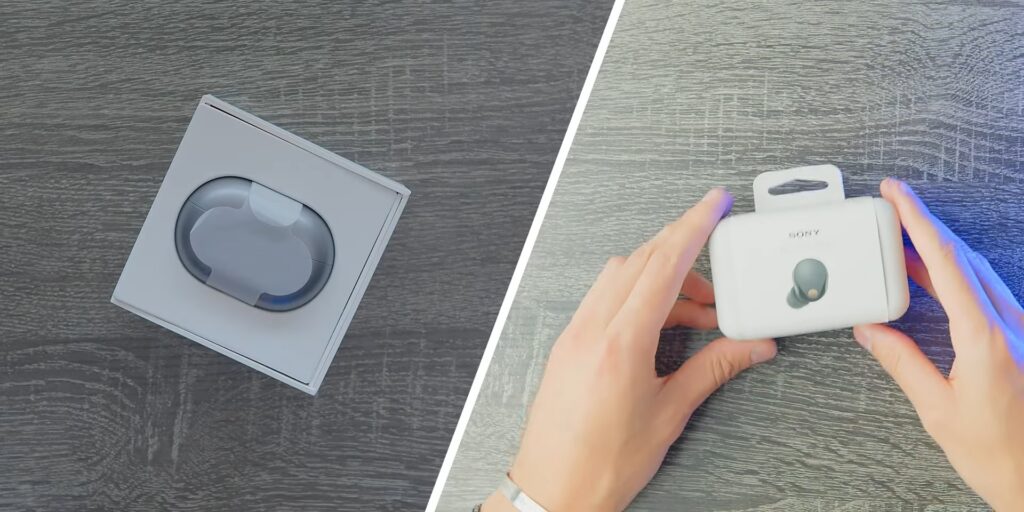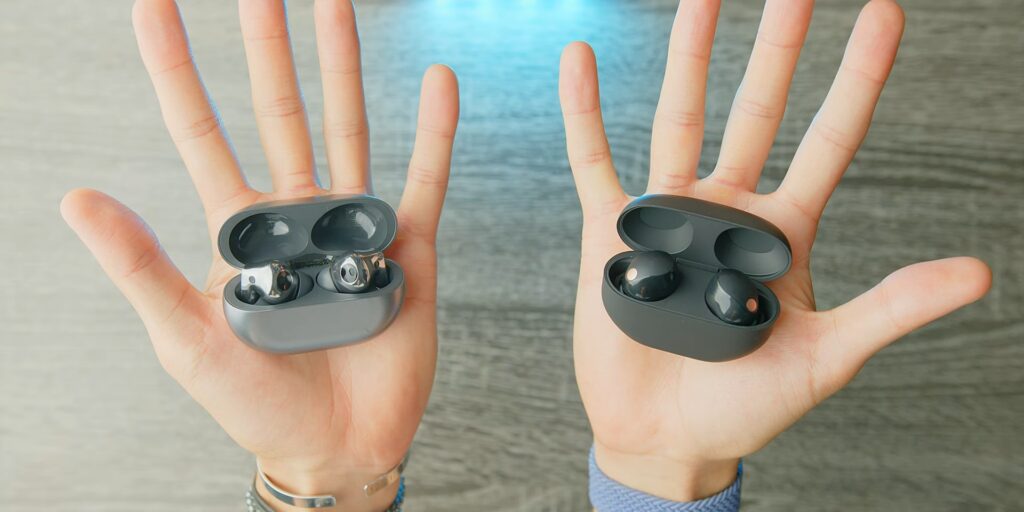The truly wireless earbuds market has witnessed a rapid evolution over the past few years, with leading brands continuously pushing the boundaries of technology and innovation. In this article, we’ll delve into an extensive comparison between two of the most impressive contenders in this space in 2023: the Sony WF1000XM5 and the Huawei FreeBuds Pro 2. We will dive into various aspects of these earbuds to help you decide which one deserves a spot in your ears.
Packaging
We’ll start with the topic of packaging, which is often the first impression that matters to many people. Personally, I don’t care much, but since many are interested, I’ll include it. In this case, Huawei’s box is quite normal and generic, made of regular cardboard with nothing remarkable. Sony’s box is made of recycled materials and opens in a more original way, in my opinion. It’s more fun, and I prefer it. So, the point goes to Sony’s headphone box.

The Case: First Impressions
Now, let’s talk about the case. Both cases are a good size, with Huawei’s being slightly larger but not significantly. Both fit comfortably in your pocket without any issues. The materials of the cases differ a bit. Huawei’s case is made of simple plastic that feels robust and well-made. In all the time I’ve had it, I’ve only noticed a few marks on the back. On the other hand, Sony’s case is made of a softer matte plastic, which feels better when you take it out of the box. However, after a couple of days of use, it tends to get micro-scratches quite easily, even with light handling. You have to be very careful to keep it looking as premium as it did when you first unboxed it. Because of this, I would give a slight advantage to Huawei’s headphones in this category. However, the level of wear can vary depending on how you use the headphones. In my experience, both are prone to minor scratches, so I’ll give a small advantage to Huawei’s headphones in this category.
Both headphones have a charging port conveniently located and a button for pairing. Sony’s headphones have it at the back, while Huawei’s headphones have it on the side. The hinges of both cases open magnetically, close securely, and feel of good quality.
Design and Durability
Design is a matter of personal preference, and what appeals to one person may not resonate with another (only the headphones, not the case). Sony’s WF1000XM5 boasts a combination of matte and shiny plastic elements, while Huawei’s FreeBuds Pro 2 shines with glossy plastic finishes. Both exude a premium feel and aesthetic, but Sony takes the lead in terms of water resistance with an IPX4 rating compared to Huawei’s IP54. This puts them on an equal footing in terms of durability.
Comfort Above All
In terms of comfort, there are differences worth highlighting, and this is crucial. Huawei’s ear tips are oval-shaped, which fits better in the ear compared to Sony’s circular ear tips. It’s important to note that Sony’s ear tips are made of memory foam or pseudo-memory foam with the mesh directly integrated into the tips. This makes it difficult to replace them if you want to try different ones.
Additionally, the stick-shaped design of Huawei’s headphones sits better in the lower part of my ear compared to Sony’s, which is a personal preference. I believe Huawei’s design will fit most people better than Sony’s. In my opinion, comfort is a vital category. However, keep in mind that comfort is subjective, and what fits me well may not fit you the same way.
Mastering the Controls
Moving on to controls, it’s unfortunate that there isn’t a clear winner. Sony’s headphones have a touch panel that is easy to use and offers good audio feedback. However, the gesture options that can be configured from the app are limited. You can only choose from a specific set of actions for each earbud. On the other hand, Huawei’s headphones have a force sensor on the stick, allowing you to swipe up or down to control volume, play/pause, skip tracks, toggle noise cancellation, and more. Moreover, this can be done with a single earbud. I’ve mentioned it before, and I’ll say it again: Huawei’s headphones have the best controls I’ve experienced in truly wireless earbuds. So, the clear advantage goes to Huawei’s headphones in this category.
Sony’s touch panel, while responsive, offers fewer customizable gestures. The convenience and versatility of Huawei’s controls make it the standout performer.
Seamless Connectivity
Effortless connectivity is essential for a hassle-free experience. Both Sony and Huawei excel in this aspect. These earbuds establish quick connections with smartphones and computers alike. Furthermore, the range and latency performance of both earbuds is quite similar, offering users a seamless experience in this regard.
App Usability
A functional app can enhance the user experience, and both Sony and Huawei provide dedicated apps for their earbuds. While Sony’s app offers more noise cancellation options, it falls short in terms of usability. Users often encounter confusing menus, odd translations, and a lack of user-friendliness. In contrast, Huawei’s app is more straightforward and user-friendly, earning it an advantage in this category.
Sound Quality
Sound quality is a pivotal factor when assessing earbuds, which is quite a challenge to decide. Both headphones sound very similar, especially with high-quality music and the supported DACs. Sony’s headphones have slightly stronger bass, while Huawei’s headphones deliver a slightly cleaner and clearer sound. The differences are minimal. Unless you can compare them side by side with the same songs and identical conditions, it’s difficult to notice significant variations. Both headphones can be customized for sound through their apps, making these differences less important. So, because they sound so similar, I can’t decide on a clear winner in this category, and it’s a tie.
Crystal-Clear Microphones
Microphone quality is crucial for calls and voice commands, and both Sony and Huawei earbuds deliver impressive microphone performance. In real-world use, the distinctions between them are subtle, with slight differences in audio clarity and volume. Both earbuds offer reliable microphone capabilities for your communication needs.
Active Noise Cancellation (ANC)
Now, let’s talk about active noise cancellation (ANC), where there’s a significant topic, as I mentioned earlier. Sony’s headphones offer a wide range of options for configuring ANC, even based on what you’re doing. It works well, but personally, I don’t use most of these options. I prefer a simpler approach—either I turn ANC to the maximum or turn it off. Both headphones have ambient modes that work well, but Sony’s seems more natural as if you’re not wearing anything. It’s great that you can talk to activate ambient mode with Sony’s headphones while ANC is on. Sony’s headphones excel in ANC power, providing a slightly better performance, and isolating noise by about 5-10% more compared to Huawei’s headphones. Sony’s headphones are currently the best in the market for ANC, but the difference isn’t as significant as expected. Nevertheless, Sony’s app offers additional functionality for ANC, which is why I’ll give them a full three points in this category.
Battery Life and Charging
Battery life is a crucial consideration when selecting wireless earbuds, and this is an area where Sony significantly outperforms Huawei. The Sony WF1000XM5 provides an exceptional battery life of approximately 7 hours and 6 minutes, while Huawei’s FreeBuds Pro 2 offers a respectable but shorter 4 hours and 21 minutes of playback time. This substantial difference highlights Sony’s superiority in this category.
Both earbuds come equipped with Type-C charging ports, making it easy to recharge them, and they also support wireless charging, adding convenience to your charging experience.
Price Tag Matters
The price is often a deciding factor for many consumers, and in this regard, Huawei’s FreeBuds Pro 2 stands out as the more budget-friendly option. Official prices on the respective brand websites indicate that Huawei’s earbuds are significantly cheaper than Sony’s, making them an attractive choice for cost-conscious consumers. However, it’s worth noting that both earbuds are often available at lower prices on platforms like Amazon, leveling the playing field.
Final verdict
In summary, considering all the categories and assessments, Huawei’s headphones come out as the clear winner in this comparison. I was expecting a more competitive battle, but Huawei’s headphones shine in terms of comfort and price, making them my preferred choice. Sony’s headphones aren’t bad, but they are quite expensive considering their drawbacks, at least in my opinion. However, the choice ultimately depends on your priorities. If battery life is crucial for you, Sony might be the better option. If you prefer a particular feature or design, your choice might differ. I present the categories and my experiences, but the final decision is yours.
When selecting wireless earbuds, it’s important to consider your own priorities and how each aspect aligns with your needs. By carefully weighing these factors, you can make an informed decision and choose the earbuds that best complement your lifestyle and listening preferences.
| Classification | Sony WF1000XM5 | Huawei FreeBuds Pro 2 |
|---|---|---|
| Comfort | – | ✔️ |
| Design | – | ✔️ |
| Case | ✔️ | – |
| Charging | – | – |
| Connectivity | – | – |
| Controls | – | ✔️ |
| App | – | ✔️ |
| Microphones | – | – |
| Active Noise Cancellation (ANC) | ✔️ | – |
| Sound Quality | – | – |
| Price | – | ✔️ |

